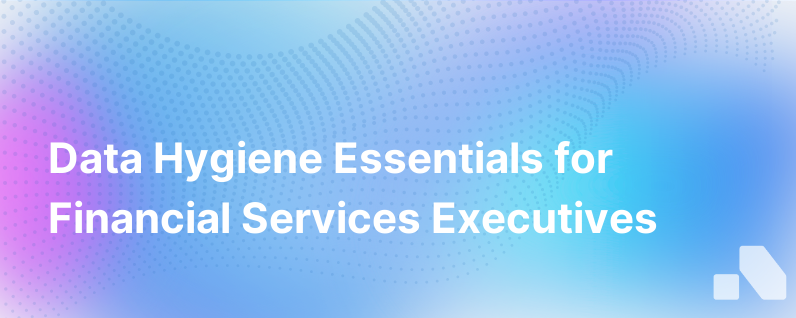
Data has become the new currency of financial services firms. In a landscape bustling with transactions, security trades, customer interactions, and regulatory submissions, the integrity of data forms the bedrock of trust and strategic decision-making. However, maintaining clean, accurate, and compliant data, colloquially known as data hygiene, is a process fraught with challenges.
In the financial sector, poor data hygiene can have repercussive consequences — from regulatory penalties and operational inefficiencies to lost revenue opportunities and erosion of client trust. Hence, instituting best practices for data hygiene is not merely a recommended course but a quintessential stride for any financial services firm seeking sustainability and competitive advantage.
In this article, we will explore the foundational data hygiene best practices essential for financial services firms.
Understanding Data Hygiene in Financial Services
Data hygiene encompasses the processes and practices a firm undertakes to ensure the cleanliness, accuracy, completeness, and integrity of its data throughout its lifecycle. In financial services, this involves tackling issues such as data duplication, inaccuracy, aging, and non-compliance.
Why Data Hygiene Matters
The impact of poor data hygiene can resonate through the very framework of financial services:
- Inaccurate client profiles, leading to incorrect targeting and poor customer service.
- Non-compliance with regulations like GDPR, MiFID II, or CCPA, leading to hefty penalties.
- Erroneous financial entries resulting in financial misstatements and lack of faith in reporting standards.
Data Hygiene Best Practices
Financial services firms seeking to bolster their data hygiene can adopt the following best practices:
1. Establish a Data Governance Framework
Crafting a data governance framework is the first critical step towards ensuring data quality. A governance framework defines roles, responsibilities, and processes to manage the firm’s data assets. It includes:
- Establishing clear data ownership and stewardship roles.
- Creating data quality standards tailored to the financial industry.
- Defining data lifecycle management procedures.
2. Implement Data Standardization Processes
Standardization is key to maintaining high-quality data. It ensures that data from different sources adhere to the same format, making it easier to merge, analyze, and process. This includes:
- Utilizing standard data formats like ISO for date, currency, etc.
- Employing common identifiers like LEI (Legal Entity Identifier) for entity data.
3. Systematic Data Cleaning
Instituting routine data cleaning processes helps to eliminate inaccuracies, remove duplicates, and correct errors. Data cleaning should be done regularly and include:
- Scrubbing data entry processes to correct input errors.
- Running reconciliation processes to identify and rectify discrepancies.
- Applying algorithmic methods to detect outliers and anomalies.
4. Data Quality Management Tools
There are a plethora of data quality management tools designed to help financial institutions in automating the cleaning process. These tools can:
- Conduct real-time data quality checks.
- Offer dashboards with visual insights into data quality metrics.
- Integrate easily with existing financial systems.
5. Continual Data Monitoring
A proactive approach with continuous monitoring can identify issues before they escalate. This involves:
- Implementing systems to generate alerts when data quality thresholds are breached.
- Performing regular audits of data to ensure ongoing cleanliness.
- Monitoring the data-related processes for compliance with governance policies.
6. Training and Culture
Culture shapes behavior, and behavior determines data quality. Training programs and a culture that emphasizes the importance of data hygiene can greatly enhance a firm’s data quality. This includes:
- Education on the impact of data hygiene on the firm’s success.
- Promotion of best practices related to data entry, management, and usage.
7. Ensure Compliance with Regulations
Regulatory adherence is non-negotiable in financial services. Data hygiene practices must incorporate:
- Adhering strictly to privacy laws and industry-specific regulations.
- Retaining records in accordance with legal requirements.
- Conducting periodic reviews of compliance-related data processes.
8. Leverage Data Integration Techniques
Given the disparate data systems often in play at financial firms, integration is vital for maintaining data accuracy. Effective integration techniques involve:
- Using middleware and APIs to ensure seamless data flow between systems.
- Employing deduplication strategies when integrating data sources.
9. Master Data Management
Master data management (MDM) is establishing a single source of truth for key pieces of data involving clients, products, transactions, etc. MDM strategies include:
- Centralizing critical data assets.
- Harmonizing data across departments and business lines.
10. Engage in Data Usage Reporting
Lastly, the ability to track how data is being accessed and utilized within the firm can offer insights into potential hygiene issues:
- Implementing reporting mechanisms that map data usage patterns.
- Reviewing data access logs to ensure only authorized personnel interact with sensitive data.
By paying close attention to these data hygiene best practices, financial services firms can preserve the integrity of their data assets. This pursuit brings them a cadence away from operational snags while aligning their compliance compass and sharpening their strategic acumen.
In a financial landscape where data serves as the lifeblood, hygiene is not just a technical endeavor; it is a strategic imperative. Firms that inculcate a robust data hygiene culture will not only facilitate regulatory adherence and operational efficiency but also harvest the foresight that informed decision-making affords.
Investing in data hygiene is a journey with an unequivocal destination — an enterprise that is compliant, accurate, and poised for growth. Amidst the backdrop of an increasingly data-centric world, financial services firms that commit resources and focus on these best practices will carve out a distinctive edge in the competitive market.